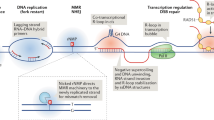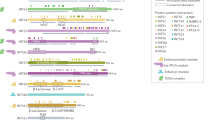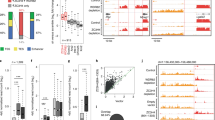Abstract
The formation of R-loops is a natural consequence of the transcription process, caused by invasion of the DNA duplex by nascent transcripts. These structures have been considered rare transcriptional by-products with potentially harmful effects on genome integrity owing to the fragility of the displaced DNA coding strand1. However, R-loops may also possess beneficial effects, as their widespread formation has been detected over CpG island promoters in human genes2,3. Furthermore, we have previously shown that R-loops are particularly enriched over G-rich terminator elements. These facilitate RNA polymerase II (Pol II) pausing before efficient termination4. Here we reveal an unanticipated link between R-loops and RNA-interference-dependent H3K9me2 formation over pause-site termination regions in mammalian protein-coding genes. We show that R-loops induce antisense transcription over these pause elements, which in turn leads to the generation of double-stranded RNA and the recruitment of DICER, AGO1, AGO2 and the G9a histone lysine methyltransferase. Consequently, an H3K9me2 repressive mark is formed and heterochromatin protein 1γ (HP1γ) is recruited, which reinforces Pol II pausing before efficient transcriptional termination. We predict that R-loops promote a chromatin architecture that defines the termination region for a substantial subset of mammalian genes.
This is a preview of subscription content, access via your institution
Access options
Subscribe to this journal
Receive 51 print issues and online access
$199.00 per year
only $3.90 per issue
Buy this article
- Purchase on Springer Link
- Instant access to full article PDF
Prices may be subject to local taxes which are calculated during checkout




Similar content being viewed by others
References
Aguilera, A. & Garcia-Muse, T. R loops: from transcription byproducts to threats to genome stability. Mol. Cell 46, 115–124 (2012)
Ginno, P. A., Lott, P. L., Christensen, H. C., Korf, I. & Chedin, F. R-loop formation is a distinctive characteristic of unmethylated human CpG island promoters. Mol. Cell 45, 814–825 (2012)
Ginno, P. A., Lim, Y. W., Lott, P. L., Korf, I. & Chedin, F. GC skew at the 5′ and 3′ ends of human genes links R-loop formation to epigenetic regulation and transcription termination. Genome Res. 23, 1590–1600 (2013)
Skourti-Stathaki, K., Proudfoot, N. J. & Gromak, N. Human senataxin resolves RNA/DNA hybrids formed at transcriptional pause sites to promote Xrn2-dependent termination. Mol. Cell 42, 794–805 (2011)
Nakama, M., Kawakami, K., Kajitani, T., Urano, T. & Murakami, Y. DNA–RNA hybrid formation mediates RNAi-directed heterochromatin formation. Genes Cells 17, 218–233 (2012)
Gullerova, M. & Proudfoot, N. J. Cohesin complex promotes transcriptional termination between convergent genes in S. pombe. Cell 132, 983–995 (2008)
Zofall, M. et al. Histone H2A.Z cooperates with RNAi and heterochromatin factors to suppress antisense RNAs. Nature 461, 419–422 (2009)
Schönborn, J. et al. Monoclonal antibodies to double-stranded RNA as probes of RNA structure in crude nucleic acid extracts. Nucleic Acids Res. 19, 2993–3000 (1991)
Jenuwein, T. The epigenetic magic of histone lysine methylation. FEBS J. 273, 3121–3135 (2006)
Tachibana, M. et al. Histone methyltransferases G9a and GLP form heteromeric complexes and are both crucial for methylation of euchromatin at H3-K9. Genes Dev. 19, 815–826 (2005)
Rice, J. C. et al. Histone methyltransferases direct different degrees of methylation to define distinct chromatin domains. Mol. Cell 12, 1591–1598 (2003)
Vakoc, C. R., Mandat, S. A., Olenchock, B. A. & Blobel, G. A. Histone H3 lysine 9 methylation and HP1γ are associated with transcription elongation through mammalian chromatin. Mol. Cell 19, 381–391 (2005)
Mateescu, B., Bourachot, B., Rachez, C., Ogryzko, V. & Muchardt, C. Regulation of an inducible promoter by an HP1β-HP1γ switch. EMBO Rep. 9, 267–272 (2008)
Saint-André, V., Batsché, E., Rachez, C. & Muchardt, C. Histone H3 lysine 9 trimethylation and HP1γ favor inclusion of alternative exons. Nature Struct. Mol. Biol. 18, 337–344 (2011)
Smallwood, A. et al. CBX3 regulates efficient RNA processing genome-wide. Genome Res. 22, 1426–1436 (2012)
Nojima, T., Dienstbier, M., Murphy, S., Proudfoot, N. J. & Dye, M. J. Definition of RNA polymerase II CoTC terminator elements in the human genome. Cell Rep. 3, 1080–1092 (2013)
Kubicek, S. et al. Reversal of H3K9me2 by a small-molecule inhibitor for the G9a histone methyltransferase. Mol. Cell 25, 473–481 (2007)
Rosenbloom, K. R. et al. ENCODE data in the UCSC Genome Browser: year 5 update. Nucleic Acids Res. 41, D56–D63 (2013)
Frietze, S., O’Geen, H., Blahnik, K. R., Jin, V. X. & Farnham, P. J. ZNF274 recruits the histone methyltransferase SETDB1 to the 3′ ends of ZNF genes. PLoS ONE 5, e15082 (2010)
Alló, M. et al. Control of alternative splicing through siRNA-mediated transcriptional gene silencing. Nature Struct. Mol. Biol. 16, 717–724 (2009)
Gentleman, R. C. et al. Bioconductor: open software development for computational biology and bioinformatics. Genome Biol. 5, R80 (2004)
Karolchik, D. et al. The UCSC Table Browser data retrieval tool. Nucleic Acids Res. 32, D493–D496 (2004)
Bastos, R. N., Penate, X., Bates, M., Hammond, D. & Barr, F. A. CYK4 inhibits Rac1-dependent PAK1 and ARHGEF7 effector pathways during cytokinesis. J. Cell Biol. 198, 865–880 (2012)
Acknowledgements
This work was supported by a Wellcome Trust Programme grant (091805/Z/10/Z) and a European Research Council Advanced grant (339270-polyloop) to N.J.P., and a Marie Curie Actions grant from EU FP7 (REA grant agreement, 327985) to K.K.-G. We are grateful to R. Nunes Bastos for valuable help with immunofluorescence/imaging analysis and figure formatting. We also thank Q. Sun for helpful discussions and advice. We thank R. J. Crouch for the gift of the GFP-RNase H1 expression plasmid, G. Hannon for the Ago2-knockout mouse cell line and Y. Shinkai for the G9a/Glp double-knockout mouse embryonic stem cells.
Author information
Authors and Affiliations
Contributions
K.S.-S. performed all the molecular biology and imaging experiments. K.K.-G. performed the bioinformatics analysis. K.S.-S. and N.J.P. designed the experiments and wrote the manuscript.
Corresponding author
Ethics declarations
Competing interests
The authors declare no competing financial interests.
Extended data figures and tables
Extended Data Figure 1 H3K9me2 and H3 levels over human β-actin gene.
a, Left, H3K9me2 ChIP on β-actin gene. Right, H3K9me2 ChIP analysis on human centromere 9 (positive control). b, Left, H3 ChIP on β-actin gene. Right, H3 ChIP analysis on human centromere 9. c, Left, H3K9me2 ChIP with or without BIX treatment. Right, H3 ChIP with or without BIX treatment. ChIP values are ±s.d. from three biological repeats. C and D indicate C and D termination probes, respectively. cen, centromere; in, intron; p(A), poly(A); prom, promoter.
Extended Data Figure 2 R-loops and the H3K9me2 repressive mark are not specifically enriched over the CoTC terminators of human cyclin B1 and akirin 1 genes.
a, DIP on endogenous cyclin B1 and akirin 1 genes. No detection of R-loops was observed over their CoTC terminators. Human β-actin gene was used as a positive control. For cyclin B1 and akirin 1 genes, 3′-end 1 and 3′-end 2 amplicons amplify two different regions within the CoTC terminator of each gene. 3′-end 1 and 3′-end 2 amplicons for the β-actin gene amplify the 5′ pause and pause amplicons, respectively. b, Ratio of H3K9me2 signal over the 3′ ends versus intron 3 signal in cyclin B1, akirin 1 and β-actin human genes. DIP and ChIP values are ±s.d. from three biological repeats.
Extended Data Figure 3 Cellular localization of R-loops, dsRNA and H3K9me2.
a, Immunofluorescence imaging of dsRNA (J2 antibody) and R-loops (S9.6 antibody), using paraformaldehyde (PFA) and methanol (MeOH) as fixing reagents. Fixation with methanol allowed visualization of R-loops and dsRNA in HeLa cell nuclei. Enlarged boxes (1 and 2) are shown in right panels. b, Whole-cell images showing immunofluorescence of H3K9me2 with dsRNA (J2; top) and R-loops (S9.6; bottom). Enlarged versions (1 and 2) are shown in Fig. 2h.
Extended Data Figure 4 R-loops and RNAi promote the H3K9me2 mark over mouse β-actin terminator.
a, DIP performed on mouse β-actin gene in MEFs. b, RT–qPCR of total RNA from MEF cells on β-actin gene to detect antisense transcripts with region-specific forward primers. Average RT–qPCR values are ±s.d. from four biological repeats. c, Ago1 ChIP performed on mouse β-actin gene in MEFs. ChIP signal is normalized to intron 1 signal. d, Left, ratio of H3K9me2 ChIP signal versus H3 on mouse β-actin in MEFs. Middle, normalized H3K9me3 to total H3 levels. Right, ratio of H3K9me2 and H3K9me3 signal versus H3 signal on major satellites in MEFs. e, Ago1 ChIP in wild-type (grey bars) and Ago2-knockout (KO) (white bars) cells. Ago1 recruitment over mouse β-actin is enhanced upon Ago2 depletion. f, Left, ratio of H3K9me2 ChIP signal versus total H3 on β-actin gene in wild-type and G9a/Glp double-knockout mouse embryonic stem cells. Right, H3K9me2/H3 ratio on the mouse major satellites in wild-type and G9a/Glp double-knockout cells. Average ChIP and DIP values are ±s.d. from three biological repeats.
Extended Data Figure 5 H3K9me2, H3K9me3 and H3 levels over the endogenous mouse β-actin gene.
a, H3K9me2 and H3K9me3 ChIP on mouse β-actin gene in MEF cells. Right, H3K9me2 and H3K9me3 ChIP on mouse major satellites (positive control). b, Total H3 ChIP on mouse β-actin gene. Major satellites were used as a positive control. ChIP values are ±s.d. from three biological repeats.
Extended Data Figure 6 H3K9me2 and H3 levels over mouse β-actin gene in G9a/Glp double-knockout mouse embryonic stem cells and Ago2-knockout MEFs.
a, Top and bottom, H3K9me2 and H3 ChIP performed on mouse β-actin gene in wild-type and G9a/Glp double-knockout embryonic stem cells. H3K9me2 occupancy depends on the presence of G9a/Glp HKMTs. Right, H3K9me2 and H3 ChIP performed on mouse major satellites in wild-type and G9a/Glp double-knockout cells. b, ChIP analyses using H3K9me2 (top) and H3 (bottom) antibodies performed on mouse β-actin gene in wild-type and Ago2-knockout cells. ChIP values are ±s.d. from three biological repeats.
Extended Data Figure 7 R-loop formation and antisense transcription are Ago2- and G9a/GLP-independent.
a–c, DIP performed on mouse β-actin gene in wild-type, Ago2-knockout (a) and G9a/Glp double-knockout (c) cells. b, Pol II ChIP in wild-type (grey bars), wild-type overexpressing RNase H1 (black bars), Ago2-knockout (white bars) and Ago2-knockout overexpressing RNase H1 (red bars) MEFs. Hatched box quantifies Pol II read-through transcription versus promoter signal. d, RT–qPCR analysis of total RNA from wild-type and G9a/Glp double-knockout cells for the mouse β-actin gene. RT reaction was performed with specific forward primers. Average DIP and RT–qPCR values are ±s.d. from three biological repeats.
Extended Data Figure 8 HP1γ, G9a and R-loops are globally associated with paused Pol II over PTTs.
a, Genomic annotation of HP1γ based on ChIP-seq peak summit localization (HP1γ annotation, pie chart on the left) and the fold enrichment of HP1γ over the indicated genomic regions (table on the right) as compared to their base-pair coverage in the human genome (genome annotation, pie chart in the middle). Genic regions were defined by RefSeq gene coordinates (hg19). Promoter regions were defined as regions 1 kb upstream of RefSeq gene TSS excluding intervals overlapping with any genic regions. Termination regions were defined as regions 5 kb downstream of RefSeq genes excluding intervals overlapping with any genic region or promoter. b, HP1γ ChIP-seq enrichment profile in 10-kb regions surrounding the TSS (left graph) and PAS (right graph). HP1γ peaks summit frequencies are plotted in 500-bp bins. c, Box plot showing the average log2 (G9a/input) ChIP-chip signal distribution in PTT candidate regions (right box), randomly sampled regions of the same size and number as PTT candidate regions (random regions, left box), and in HP1γ peaks outside of PTT candidate regions (non-PTT HP1γ peaks, middle box). In all box plots the horizontal line in the box shows the median, the lower and upper limits of the box show respectively the first and third quartile, and the whiskers extend to the non-outlier extreme data points. The log2 (G9a/input) signal is significantly higher in the PTT candidate regions compared to random regions (P = 0.0001067) as well as compared to non-PTT HP1γ peaks (P = 0.02213). The log2 (G9a/input) signal is also significantly higher in non-PTT HP1γ peaks compared to random regions (P = 0.0009337). The Wilcoxon Mann–Whitney test was applied in all cases. d, DRIP-seq profile over the centre of PTT candidate regions. Read frequencies of DRIP sample (black curve) and DRIP RH1 sample (red curve) are plotted in 500-bp bins, both normalized to million mapped reads. e, Box plot showing DRIP-seq2 read density (RPKM) of DRIP sample compared with DRIP RH1 control in PTT candidate regions. P < 2.2 × 10−16 determined by Wilcoxon signed-rank test. f, Box plot of PolIIS2ph pausing index over PTTs (relative to gene bodies) in the BIX RH1 sample (right) and the untreated sample (left). P = 3.398 × 10−16 using the Wilcoxon signed-rank test. g, Box plot displaying the ratio of PolIIS2ph pausing index in the BIX RH1-treated sample compared with the untreated sample in TSS regions (±1 kb, left) and in PTT regions (right). P = 2.468 × 10−15 using the Wilcoxon Mann–Whitney test.
Extended Data Figure 9 ENSA and GEMIN7 share features of R-loop mediated PTT.
a, DIP on ENSA and GEMIN7 genes. R-loops specifically enriched over 3′ ends (grey bars), compared to promoter regions (white bars). Human β-actin gene is positive control. Values ± s.d. for three biological repeats. b, RT–qPCR of total RNA from HeLa cells performed on indicated gene. RT reaction was performed with promoter or 3′-end-specific forward primer to detect antisense transcript. Average RT–qPCR values are ±s.d. from four biological repeats. c, DICER ChIP of ENSA and GEMIN7 genes over promoters and termination regions. d, Left, ratio of H3K9me2 ChIP signal versus H3 on GEMIN7 and β-actin genes. Right, ratio of H3K9me2 signal versus H3 on ENSA gene. e, f, H3K9me2 and H3 ChIP for ENSA and GEMIN7 genes over promoter (white bars) and pause terminators (grey bars). β-Actin gene was used as a positive control. g, HP1γ ChIP for ENSA and GEMIN7 genes over intronic and 3′-end regions. ChIP values are ±s.d. from three biological repeats.
Extended Data Figure 10 Model for how R-loops and RNAi-dependent H3K9me2 chromatin mediate pause-type termination in mammalian genes.
Mammalian genes possessing pause elements downstream of their PAS form R-loops in termination regions. This facilitates generation of an antisense transcript that hybridizes with the sense transcript to form dsRNA. This triggers recruitment of the RNAi factors, DICER, AGO1 and AGO2. G9a/GLP HKMTs and HP1γ are then recruited, forming and maintaining H3K9me2 repressive marks. R-loops and H3K9me2 facilitate Pol II pausing before termination. DNA is shown as grey lines and RNA as a red line. Points of contact between the DNA strand and nascent RNA indicates R-loop formation, whereas points of contact between sense and antisense RNA indicate dsRNA formation. Pol II is shown as a blue icon with arrow indicating transcription direction. Nucleosomes are shown in green except over H3K9me2 region where they are coloured red.
Supplementary information
Supplementary Information
This file contains Supplementary Table 1. (PDF 112 kb)
Rights and permissions
About this article
Cite this article
Skourti-Stathaki, K., Kamieniarz-Gdula, K. & Proudfoot, N. R-loops induce repressive chromatin marks over mammalian gene terminators. Nature 516, 436–439 (2014). https://doi.org/10.1038/nature13787
Received:
Accepted:
Published:
Issue Date:
DOI: https://doi.org/10.1038/nature13787
This article is cited by
-
APOBEC3B regulates R-loops and promotes transcription-associated mutagenesis in cancer
Nature Genetics (2023)
-
Elongation roadblocks mediated by dCas9 across human genes modulate transcription and nascent RNA processing
Nature Structural & Molecular Biology (2023)
-
The RNA m5C modification in R-loops as an off switch of Alt-NHEJ
Nature Communications (2023)
-
CCIVR2 facilitates comprehensive identification of both overlapping and non-overlapping antisense transcripts within specified regions
Scientific Reports (2023)
-
R-LOOPs on Short Tandem Repeat Expansion Disorders in Neurodegenerative Diseases
Molecular Neurobiology (2023)
Comments
By submitting a comment you agree to abide by our Terms and Community Guidelines. If you find something abusive or that does not comply with our terms or guidelines please flag it as inappropriate.



